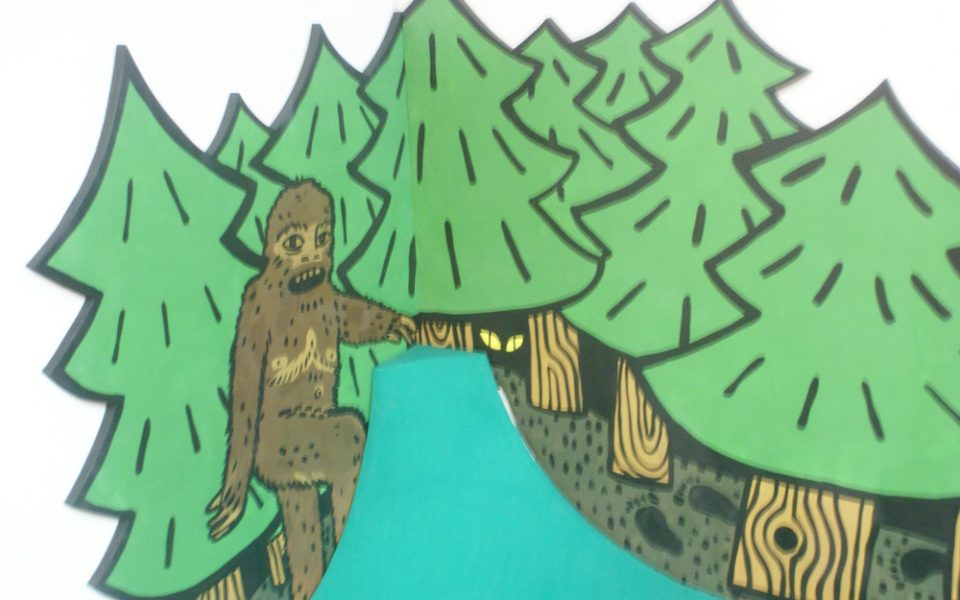Matthew Cravey furrowed his brow as he overshot one of his strokes, then watched the golf ball ricochet off a metal ramp and roll all the way to the gallery entrance. Cravey and his wife, Nancy, and son, Isaac, had just teed off on Michael Clapp’s deceptively difficult putt-putt hole at the Center for Visual Arts in downtown Greensboro last Sunday.
Nancy and Isaac keeled over laughing, leaning onto their putters. Matthew addressed the ball in the doorframe, about 20 feet away from the hole, and took another stroke. The ball careened across the cement floor and landed deeper in the rough, nowhere near Clapp’s structure. That was funny too.
There’s a delicate balance to creating the perfect putt-putt course. Make the shots too difficult and the game becomes work. Too easy, and the game bores the player; taking them out of the experience. How can designers create a challenge that appeals to both rookie and veteran mini-golfers?

Gate City Acres is part of a nationwide trend in which artists design their own mini-golf courses. The Walker Arts Institute hosts the most famous example during its annual putt-putt fundraiser in Minneapolis. The monthlong exhibit of nine putt-putt holes provides local artists with the challenge of combining beautiful aesthetics and clever game design. Golfers interpret each hole like attendees observing paintings in an art gallery.
A good putt-putt course shows the golfer how to sink their ball in the hole without a word. Instead, each hole relies on the language of design to tell the player how they can succeed. Some of the holes at the Center for Visual Arts hide secrets or Easter eggs for the golfers to discover and discuss amongst themselves.
Hole No. 6 stands out amongst the rest. Created by artist Mark Dixon and designer Tom Dawson, it sits near a set of large windows overlooking the courtyard of Café Europa. The first obstacle is a small bridge in a black-and-white checkerboard design. Holes of various sizes line the bridge and if the ball falls into one of these openings, it lands in a faux water feature where it will then roll into the bottom of an elaborate contraption.

The structure, inspired by the plunger of a pinball machine, lets the golfer pull back a rope that’s connected to the frame of a bicycle wheel. As the player pulls the rope, the wheel turns and pulls back a small, wooden mallet. Once the rope is taut and released, the mallet whacks the golf ball up a ramp to fall inside one of two structures that each create charming chimes while the ball falls through them. Then the ball rolls onto a small patch of fake grass with the hole right in the middle.
The design of No. 6 suits players of all skill levels and ensures that anyone with an interest in putt-putt will have fun. Experienced mini-golfers can try to get a hole-in-one by narrowly avoiding the traps on the checkerboard bridge while newbies can have fun using the pinball-inspired machine to knock their ball up the ramp.
“We did a lot of online research,” said Dixon, who’s also an associate professor of art at Guilford College. “And one of the things I [found out] was that it’s standard for the hole to be mean. By that I mean, [the player] wants the ball to go one way but [instead] it’ll go down a long hill. If you end up in that situation a lot, you just end up feeling like you’re being bullied by the course.
“We felt like, Okay, there has to be a possibility for the ball to go to a place where you don’t want it to go… but what if you could have even more fun that way?”
Michael Clapp didn’t want to bully players like Cravey, the wayward dad, with the hole he designed. However, just like any piece of art, the obstacle came to life through the player’s interpretation (or, in this case, misinterpretation).
“One thing that games do well is keep the player in a highly attentive state…” said Dixon. “Some art does that well, but art can be very quiet, too. Sometimes it can require a lot of gumption on behalf of the viewer to bring deep attention to the table.”
Gate City Acres takes the interpretation process of viewing art in a museum and gamifies that challenge. Each hole provided by the Center for Visual Arts offers new experiences and possibilities for the player. While Matthew may have struggled at the beginning of the course, he still had eight more pieces of art to contend with.
Reserve time on the course online here.
Join the First Amendment Society, a membership that goes directly to funding TCB‘s newsroom.
We believe that reporting can save the world.
The TCB First Amendment Society recognizes the vital role of a free, unfettered press with a bundling of local experiences designed to build community, and unique engagements with our newsroom that will help you understand, and shape, local journalism’s critical role in uplifting the people in our cities.
All revenue goes directly into the newsroom as reporters’ salaries and freelance commissions.


Leave a Reply